|
 |
|
| |
|
|
|
|
|
|
|
|
|
|
|
|
|
|
|
 |
|
|
| |
|
| |
| Travel Destinations Guide |
|
|
| Adventure Tours India |
|
|
|
|
 |
Biking Tours |
 |
Paragliding |
 |
Skiing |
 |
Safari Tours |
 |
Water Rafting |
 |
Trekking Tours |
 |
Camel Safari |
|
|
| |
|
|
|
|
|
|
| Pilgrimages of Jammu and Kashmir |
|
| Back |
Buddhism, especially the Trans-Himalayan Buddhism from Tibet is the very essence of living in Ladakh . Partly because of the royal patronage, the central part of Ladakh has the greatest concentration of major Gompas or monasteries. Monasteries of Phiyang, Hemis and Chemrey belong to the Namgyal dynasty period and are a major attraction during their monastic festivals. The reformist group monasteries are also well represented in central Ladakh by Thikse, Likkir, Rhidzong and Spituk. Buddhist study centers have been set up at both Leh and Choglamsar. Summer meditation sessions are held at the Mahabodhi Meditation Center on Changspa Lane.
It is mainly along the course of this valley system that the region's 10,000 strong, mainly Buddhists population lives. Spread over an estimated geographical area of 5000 sq. kms, High rise, mountains and deep gorges surround Zanskar. The area remains inaccessible for nearly 8 months a year due to heavy snowfall resulting in closure of all the access passes, including the Penzi-la. To-day, Zanskar has the distinction of being the least interfered with microcosms of Ladakh, and one of the last few surviving cultural satellites of Tibet. Within the mountain ramparts of this lost Shangrila stand a number of ancient yet active monastic establishments. Some of these religious foundations have evolved around remote meditation caves believed to have been used by a succession of famous Buddhist saints for prolonged meditation in pursuit of knowledge and enlightenment. |
|
|
|
|
|
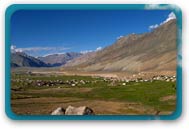  Padum Padum
Padum, situated at a height of 3505 meters, serves as the administrative headquarters of the Ladakh region. Once the capital of the ancient kingdom of Zanskar, it now houses a population of nearly 1500. Muslims constitute nearly half of the population of the town. A huge boulder near the river bank with ancient rock carving, dating back to the 8th century, is a living proof of the fact that North Indian Buddhism has had influence in this region since ancient times. Then, there is the Starrimo Monastery gripping a tree-covered ridge above the old town. The ancient Pibiting village with the hilltop monastery as its backdrop is an epitome of stupa architecture.
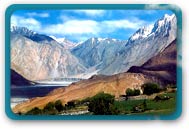  Stongdey Stongdey
The monastery of Stongdey lies 18 kms. to the north of Padum, on the road leading to Zangla. Stondey was an old foundation associated with the Tibetan Yogi, Marpa, and is now the second largest monastic establishment of Zanskar, inhabited by 60 Gelukpa monks. The sprawling whitewashed complex has a number of temples, where each temple is a repository of the region's rich monastic legacy. Stongdey can be reached by foot in about 4 hours along the recently laid rough road. The climb
up to the monastery is rather strenuous, but it is worth to enjoy the breathtaking scenery of the valley.
The monastery comprises of a number of magnificent shrines within its complex, along with some exquisite wall paintings. One of the major attractions of the Stongdey Monastery is the annual Gustor festival, which takes place in the 11th Tibetan month, on the 28th and 29th day. On the day of the festival, the monks perform the sacred dance in the monastery. The successive reincarnations of Nari Tulku serve as the incumbents here.
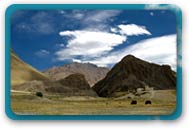  Zangla Zangla
Lying deep in the northern arm of Zanskar at the end of the 35 km long rough road from Padum, Zangla was being ruled by a titular king till his death a few years back. The old castle now in ruins except from a small chapel, occupies a hill, overlooking the desert valley below. Nearby is the old nunnery which can be visited to know the austere life style of the small monastic community of nuns. The village lies mid-way between Stongdey and Zangla. Zangla is the nodal point on the popular Padum -
Stongdey - Zangla - Karsha - Padum tour, which covers most of the cultural places of Zanskar. The old rope suspension bridge spanning the tumultuous Zanskar near Zangla, a rare feat of folk engineering, is now no more in use, but still visible. The river is now crossed by a temporary footbridge for approaching the left banks along which the trail to Karsha follows. Zangla is also the take-off point for the Padum-Markha valley treks.
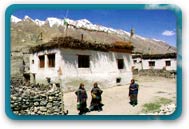  Sani Sani
Lying 6 km west of Padum, on the road to Kargil, the chief attraction of this picturesque village is the castle like monastery which is unique in its own kind. It is built on a level ground unlike other monasteries of the region.
As the legend goes, it's initial foundation is associated with Kanishka on account of the Kanika stupa which stands in the backyard of the walled complex. The main building comprises a huge multi-columned central prayer hall, housing an array of statues of popular Buddhists divinities and Drugpa (old schools) high saints. The most interesting frescoes, however, can be seen in a small, almost discarded chapel at the back of the main building, whose walls are adorned with stucco murals depicting landscapes and floral designs based on the life of Padma-sambhava. Adjoining this monastic complex is an old cemetery surrounded by a ring of ancient rock carvings which reflect Indian artistic influence.
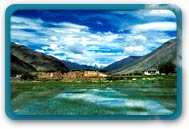  Zanskar Zanskar
About 20 kms. south of Rangdum stands the Pazila watershed across which lies Zanskar, the most isolated of all the trans Himalayan Valleys. The Panzila Top (4401 m) is the picturesque tableland adorned with two small alpine lakes and surrounded by snow covered peaks. As the Zanskar road winds down the steep slopes of the watershed to the head of the Stod Valley, one of Zanskar's main tributary valleys, the majestic Drang-Drung glacier looms into full view. The Drang-Drung glacier is perhaps the largest glacier in Ladakh, outside the Siachen formation. It is from the cliff-like snout of this extensive glacier that the Stod or Doda River, the main tributary of river Zanskar, rises. Zanskar comprises of a tri-armed valley system lying between the Great Himalayan Range and the Zanskar mountain.
The three arms radiate like star towards the west, north and south from a wide central expanse where the region's two principal drainage meet to form
the main Zanskar River. It is mainly along the course of this valley that about 10,000 strong, mainly Buddhists lives here. Spread over an estimated geographical area of 5000 square kms, high rise mountains and deep gorges surround Zanskar. The area remains inaccessible for nearly 8 months a year due to heavy snowfall resulting in closure of all the access passes, including the Penzi-la. Today, Zanskar is one of the last few surviving cultural centre of Tibet.
There are numerous Buddhist monasteries in Ladakh that serve as one of the major tourist draws. The famous monasteries of Phyang, Hemis and Chemrey belong to the Namgyal dynasty period. Then, there are the monasteries of Thikse, Likkir, Rhidzong and Spituk in central Ladakh, which belong to the reformist group. Almost every monastery in Ladakh serves as a venue for one festival or the other. Even meditation sessions are held in Ladakh in summers at the Mahabodhi Meditation Center on Changspa Lane. |
| Back |
|
|
|
|
|
|
|
|
|
|
|
|
|
|
|
